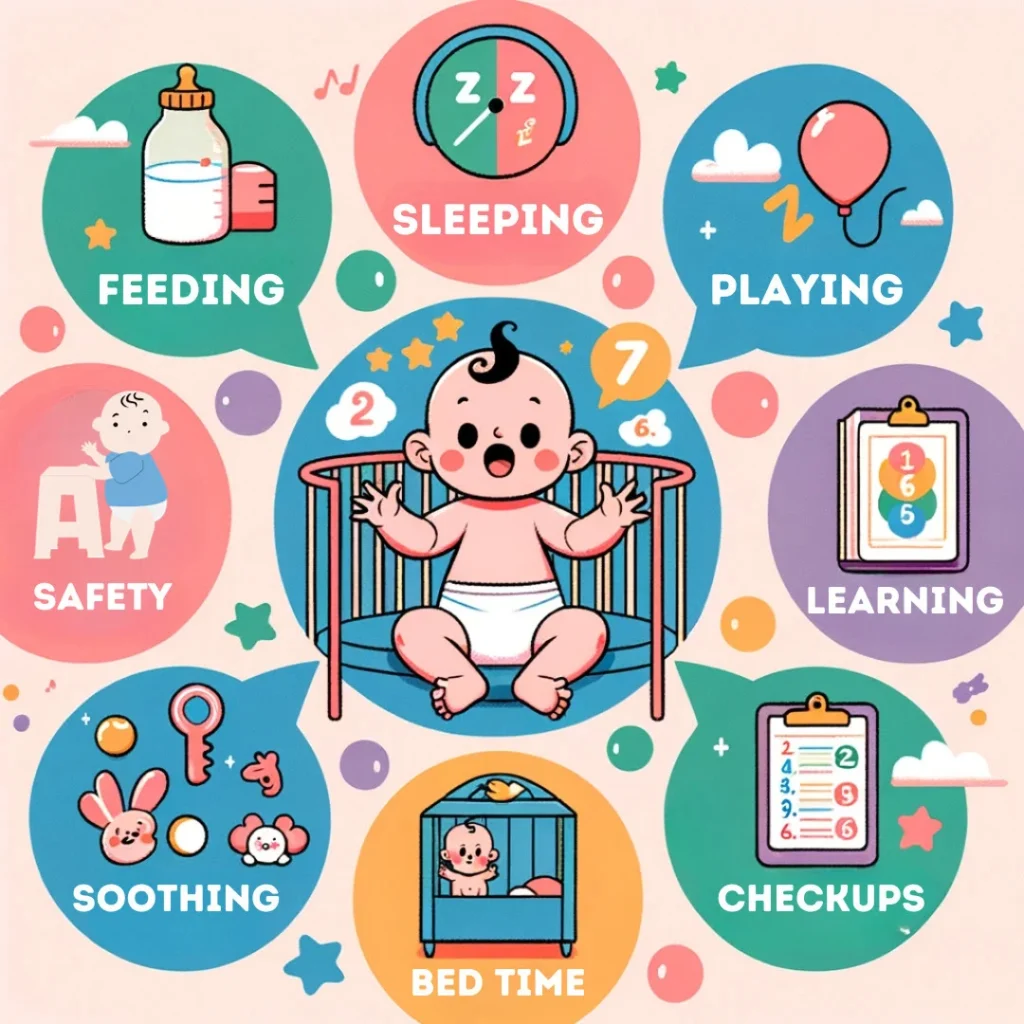Parenting Tips for Infants: How to Care for Your Newborn Baby

The exhilaration and bewilderment of bringing a new baby into your home! It’s a momentous occasion, a blend of joy and challenge that is unlike any other experience. I believe that, as new parents, you’re stepping into a realm that will test your resilience, your patience, and most significantly, your capacity to adapt. So, what’s the real deal about this overwhelming yet fulfilling journey of infancy?
I often say that being a new parent is like being thrown into the deep end of the pool. You can read all the parenting books you want, attend countless seminars on child development, and even get a heap of parenting tips for infants, but nothing quite prepares you for the emotional and psychological rollercoaster.
It’s a continuous learning process, one that often leaves you questioning your capabilities. But let me tell you, the trials are just as rewarding as the triumphs.
This guide on parenting tips for infants aims to navigate you through the intricate maze of infant parenting. We’ll delve deep into the aspects of child development, dissect the complexities of the parent-infant relationship, and equip you with actionable tips to sail smoothly through the initial stages. So, are you ready to embrace the paradox of life’s most exhausting yet most rewarding job?
Key Takeaways
| Topic | Summary |
|---|---|
| Cornerstones of Development | Witness the first smiles, giggles, and full-night sleeps as markers of emotional and psychological development. Regular pediatric check-ups are essential. |
| Nurturing Your Connection | Build an unbreakable bond through responsive care, feeding, and emotional support. Your actions create a sanctuary of trust for your child. |
| Sage Advice for New Parents | Be present, patient, and adaptable. While guidelines offer a roadmap, your intuition is your best compass. |
| Community Support | You’re not alone in this journey. Lean on family, friends, and healthcare providers for additional support and guidance. |
| Long-term Impact | The early months lay the groundwork for your child’s future, impacting them emotionally, psychologically, and physically. |
Parenting Tips For Infants After They Come Home?
In the delicate weeks following the arrival of your infant, your support system becomes your lifeline. It’s no longer just about you; it’s about the well-being of this new life you’re responsible for. I’ve always believed that parenting isn’t a solo endeavor—it’s a collective experience. So, who should be in your corner?
Where to Turn For Help and Advice
The Role of Trusted Advisors
| Role | Importance |
|---|---|
| Pediatrician | Medical advice specific to your child’s health |
| Other Parents | Emotional support and practical tips |
| Helplines | Immediate support for urgent queries |
| Friends and Relatives | Emotional well-being and occasional caregiving |
I think it’s crucial to remember that as you’re learning to support your child, it’s equally vital to find those who can support you. This is a journey not just for your baby but for you as well. How well you’re supported will reflect on your parenting, and in turn, on your child’s development. So, who’s in your corner? Are you making the most of your support system?

Infant Parenting: How To Handle Your Baby?
When you hold your newborn, you’re not just providing physical support; you’re also establishing an emotional connection. I have observed that touch, in its most fundamental form, is a language in itself—a silent dialogue between you and your baby. So how can you ensure that this tactile conversation is both safe and nurturing?
Navigating the Outside World: Car Seats and More
| Factor | Guidance |
|---|---|
| Car Seat | Ensure the car seat is appropriately installed and that your baby is securely fastened. |
| Baby Carrier | Opt for a carrier that provides ample support for your baby’s head, back, and hips. |
| Stroller | Choose one that reclines fully, allowing your newborn to lie flat during the initial months. |
I firmly believe that the way you handle your newborn lays the foundation for your future relationship. Each touch, each moment of contact, is an investment in their emotional and psychological well-being. Are you conscious of how you’re holding your baby? Are you making each touch count?
Tips To Help Bond With Your Newborn Baby?
The moment your baby arrives, you enter a dance of emotions, a choreography of emotional development, if you will. I have often noted that this dance isn’t solely led by you, the parent. Your newborn, in their innate wisdom, is an equal partner. It’s a tango that requires alertness, yet a relaxed demeanor.
Tactics to Cultivate Connection
| Strategy | Application |
|---|---|
| Love for Music | Play soft, rhythmic music during feeding times or before sleep to instill a sense of tranquility. |
| Active Engagement | When your baby is alert and relaxed, engage in activities that encourage visual and aural focus. |
| Verbal Affirmation | Though they may not understand the words, the tone of your voice conveys your emotional state. |
At trending kid stuff we firmly assert that the art of bonding with your newborn is a multi-layered experience, one that transcends mere physical care. It delves deep into the realms of emotional and psychological engagement. How are you encouraging your child’s emotional development? Are you an active participant in this intricate dance of life?
Baby Parenting: How Can I Soothe My Baby?
A crying baby can trigger a whirlwind of emotions in you, from concern to outright panic. Why is your little one crying? What can you do? I find that the answer often lies in understanding the unique language of your baby. Each cry, each fuss, is a sentence in a dialogue they are desperately trying to establish with you. So how do you decode these emotional utterances?
Quick Strategies for Instant Calm
| Approach | Explanation |
|---|---|
| Soothing Sound | Hum or sing to your baby to provide an auditory blanket of comfort. |
| Physical Comfort | A gentle pat or rub on the back can calm a fussy baby, offering them physical reassurance. |
| Visual Stimulation | Soft, colorful visuals can divert attention and alleviate fussiness. |
I’d like to emphasize that soothing a fussy or crying baby is not about silencing them but about understanding what they’re trying to communicate. It’s an invaluable skill that not only quells immediate distress but also lays the groundwork for a lifelong emotional connection. Are you tuning into your baby’s unique language? Are you equipped with strategies to transform cries into comfort?

How Do I Put A Diaper On My Baby?
Diapering a baby is more than a routine task—it’s a skill that, when done correctly, ensures your child’s health and safety. I often find that parents, especially those with their first baby, approach diapering with a blend of eagerness and apprehension. What should you know to make this daily ritual a smooth one?
The Diapering Toolkit
| Item | Purpose |
|---|---|
| Baby Wipes | For cleaning your baby’s skin gently but effectively. |
| Fresh Diapers | To replace the soiled one; always have a few at hand. |
| Barrier Cream | To prevent diaper rash and keep your baby’s skin hydrated. |
The Execution: Step-By-Step Guide
Diapering is a blend of art and science, of care and precision. I urge you to see it as more than a chore—it’s a fundamental aspect of your baby’s health and safety. Are you prepared for this daily ritual? Do you have your diapering toolkit ready to go?
How Often Should I Bathe My Baby?
You’ve brought your precious baby home, and now you’re navigating the labyrinth of new responsibilities. Among these, how often to bathe your newborn might seem like a minor concern, but I assure you, it’s a significant part of keeping your baby healthy and feeling good.
Let’s dispel a common myth: according to the American Academy of Pediatrics daily baths are not necessary. Newborns don’t engage in the kind of activities that make frequent bathing a necessity. In fact, too many baths can strip away the natural oils from your baby’s skin, making it dry and sensitive.
The Golden Rule: Less Is More
A Word on Products
Choosing the right products is crucial. Opt for those labeled as “tear-free” and “hypoallergenic” to ensure they’re gentle on your baby’s delicate skin. Also, remember that less is more when it comes to soap and shampoo; a small amount goes a long way in keeping your baby clean and smelling sweet.
In sum, bathing is not just about cleanliness; it’s a ritual that aids your baby’s sensory development and provides a wonderful opportunity for bonding. How are you approaching this fundamental aspect of your baby’s growth and development? Have you found the right balance between keeping your child clean and respecting the natural integrity of their skin?

How To Care for the Umbilical Cord and Circumcision Area?
A newborn brings a cornucopia of new experiences and challenges. Among them is the care of your baby’s umbilical cord stump and, if applicable, the circumcision area. While these might seem like minute details in the grand scheme of parenthood, proper care is essential for your child’s health and safety.
Umbilical Cord Care: A Dance with Nature
The umbilical cord stump usually dries and falls off within a few weeks of birth. During this time, it’s crucial to keep the area clean and dry. I advise using a soft, damp cloth to gently wipe around the stump. Keep the diaper folded down so that the stump is exposed to air, which aids in the drying process. If you notice any signs of infection, such as redness, swelling, or foul odor, consult your child’s pediatrician immediately.
Circumcision Care: A Symphony of Sensitivity
If your baby boy has been circumcised, special care is needed to prevent infection and promote healing. Gently clean the area with warm water during each diaper change. It’s often recommended to apply a thin layer of petroleum jelly to the tip of the penis to prevent it from sticking to the diaper. Just as with the umbilical cord, if you notice any signs of infection or prolonged bleeding, it’s vital to consult your pediatrician.
The Wisdom of Care
This is not just about hygiene; it’s a lesson in attention and responsiveness. By paying close attention to these delicate areas, you’re not just ensuring physical well-being but also establishing a foundation of attentive baby care that will follow your child through life. After all, what is parenting if not the art of mindful attention?
So, how are you navigating these nuanced aspects of newborn care? Have you found your rhythm in the dance of delicate attentiveness?

How Often Should I Feed My Baby?
The orchestra of a baby’s cry—it’s a sound that demands action. But what exactly is your little one trying to tell you? Is it hunger or something else? When it comes to feeding your baby, I believe it’s less about the clock and more about understanding signs of hunger.
The American Academy of Pediatrics recommends breastfeeding as the exclusive form of nutrition for the first six months. However, let’s not neglect the role of formula if that’s the path you’ve chosen or need to take. Either way, the key is to make sure your baby is getting sufficient nutrition for optimal growth and development.
Signs Your Baby is Ready for a Meal
Look for cues such as making sucking noises or putting their fists to their mouths. These are signals, my friends, that your baby is ready to be fed. And when should you feed them? On demand. Yes, that’s right. Forget about the rigid schedules; we’re not running a military operation here.
In the first few months of life, you should aim to feed your baby whenever they show signs of hunger. And don’t worry about overfeeding; babies have a natural mechanism to stop eating when they’re full.
Breastfeeding vs. Formula
I get it, the debate between breastfeeding and formula can be as polarizing as discussing politics at a family dinner. But here’s my take: both have their merits. Breast milk is a wondrous concoction of nutrients and antibodies, while formula is scientifically engineered to be a substantial alternative. By around six months of age, you can begin to introduce solid foods, but until then, make sure your baby’s primary source of nutrition is either breast milk or formula.
So, you see, feeding your child is less about adhering to strict schedules and more about listening, observing, and adapting. Your aim should be to provide a nourishing environment where your child can grow and develop, both physically and emotionally.
If you have concerns or questions, don’t hesitate to consult your pediatrician. After all, it’s a journey, not just for the baby but for you as well. Isn’t it fascinating how we often find ourselves learning more from our children than they do from us?
I hope this adds another layer of understanding to your parenting journey. It’s not just about filling their tummies; it’s about filling their lives with love and security. And that, my dear readers, makes all the difference.
Helping Your Babies To Sleep
Sleep! The ethereal realm where minds wander and bodies recharge. Yet, when it comes to babies, this natural process can become a complex labyrinth. Why do some infants sleep through the night while others throw tantrums as if protesting against the very idea of rest? Let’s delve into the psychology and practicality of sleep for your little ones.
Understanding Sleep Patterns
I believe that understanding the sleep patterns of infants is akin to reading a fascinating yet complicated book. During the initial months, newborns drift in and out of sleep, logging up to 16-18 hours per day. However, these hours are fragmented, lasting just 2–4 hours at a stretch. Healthychildren.org indicates that many babies start to sleep through the night by 3 months, but some may take longer. So, if your child is a night owl, don’t panic; it’s a part of their unique developmental journey.
Creating a Safe Sleep Environment
The place where your baby sleeps is not just a crib; it’s a sanctuary. The crib should be devoid of toys, blankets, or pillows that could pose a suffocation hazard. Always place your baby on their back to sleep, as recommended by experts to minimize the risk of Sudden Infant Death Syndrome (SIDS). Make sure to also keep the room at a comfortable temperature to aid in quality sleep.
Strategies for Sleep-Training
Now, let’s move to the actionable part. How can you coax your baby into a blissful night’s sleep? Here’s where my expertise in psychology and child behavior comes into play. You could establish a bedtime ritual that includes a warm bath, gentle rocking, or reading a bedtime story.
These actions serve as cues, telling your baby’s internal clock that it’s time to wind down. If your baby starts throwing a tantrum, don’t immediately rush in. Give them a moment. Sometimes, babies cry briefly but then manage to soothe themselves back to sleep. This will carry with them as they become a toddler.
Navigating the world of infant sleep is like walking a tightrope. You must balance between your child’s physiological needs and your own need for rest. It’s a journey that requires patience, adaptability, and a dash of creativity. By understanding the science behind sleep patterns, creating a safe environment, and employing smart sleep-training strategies, you’ll be well on your way to nights filled with peace—for both you and your baby.
Remember, every child is different, and what works for one may not work for another. Your role is not to enforce sleep but to facilitate it, to create the conditions under which nature can do its job. So, take a deep breath, keep learning, and you’ll soon find the perfect rhythm for you and your child.
Final Takeaway…
The first months of your baby’s life are a swirling dance of growth, learning, and adaptation—for both you and your little one. I often think of this period as the foundational chapter in the lifelong book of your child’s development. And as you turn each page, new milestones appear, providing a sense of accomplishment and anticipation for the journey ahead.
The Cornerstones of Development
In these early months, you’ll witness some of the most magical moments—first smiles, first giggles, and yes, even the first time they sleep through the night. These are not just heartwarming instances; they are indicators of your child’s burgeoning emotional and psychological development. The American Academy of Pediatrics recommends regular check-ups to track these growth markers. And while these metrics are essential, don’t forget, each child is unique. Don’t rush or compare; enjoy the ride.
Nurturing Your Connection
I believe that the bond between parent and child is like an invisible thread made of trust, love, and shared experiences. This thread strengthens each time you respond to their cries, feed them when they are hungry, or soothe them back to sleep. In these early years, you’re not just providing sustenance; you’re creating a sanctuary of trust and emotional security. Your child learns the world through you; make sure it’s a lesson of love.
Sage Advice for New Parents
If I were to offer some distilled wisdom for these transformative months, it would be this: be present, be patient, and be adaptable. Parenting is an art, not a science. While guidelines and pediatricians provide a roadmap, your intuition is the compass. Listen to it. There will be days of exhaustion, confusion, and perhaps even frustration. And that’s okay; it’s part of the journey.
As you navigate through these first months, remind yourself that you’re laying the bricks for your child’s future. It’s a monumental task, but also an incredible privilege. You’re crafting a human experience filled with love, security, and the freedom to grow. And remember, you’re not alone. You have a community, whether it’s family, friends, or healthcare providers, to lean on for support and wisdom.






